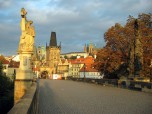Wenceslas Square is a city square in the Czech capital of Prague. Despite its name, it is in fact closer in shape to a Parisian boulevard, being almost half a mile long but barely 200 feet wide. The square is named in honor of St. Wenceslas, Bohemia’s patron saint. It is a very old square, but it only received its current name in 1848. The square became widely known in the West when it was at the center of the demonstrations that led to the Velvet Revolution in 1989.
Background and History
New Town, the area of Prague in which the square is situated, was begun in the reign of King Charles IV in the mid 14th century. At this time, the area was known as the Horse Market. It was one of a number of large open spaces in the city which were used for markets of various types. The Horse Gate was one of the most used gates in the city.
The square retained its medieval name until 1848. By this time, the cause of Czech nationalism was becoming increasingly popular. It was felt that “Horse Market” was a rather unedifying name for such an important square. The idea of renaming the area Wenceslas Square came primarily from Karel Havlíček Borovský, one of the foremost thinkers and writers of the time. In the first half of the 20th century, the square saw both the proclaiming of Czechoslovakia’s independence in 1918 and pro-Nazi rallies during the country’s occupation in WWII.
Modern History
The few buildings which had been ruined during the 1945 Prague Uprising were quickly replaced by large stores under communist rule. The square nevertheless became the focus for several anti-communist demonstrations. Notably, one large demonstration took place after the Soviet invasion of the country in order to put down the liberalization attempted during the “Prague Spring” in 1968. Among the most significant of these was the public suicide of Jan Palach, who set himself ablaze in the square in January 1969.
Further unrest occurred in March 1969, after Czechoslovakia beat the Soviet Union in the world ice hockey championships. A crowd estimated at 150,000 flocked to the square, both to celebrate their team’s victory and to protest the fact that the USSR was still occupying their country. Although there was little serious violence, there were several minor confrontations with the police, and the vandalizing of Aeroflot’s office, provoked by state agents, provided an excuse for a government crackdown on dissent.
The Square Today
The peaceful demonstrations which helped to bring down the communist regime during the fall of 1989 were the source of the term “Velvet Revolution.” Among the most historically significant speeches given in the square at that time were those by Alexander Dubček, the man who had instigated the Prague Spring and been humiliated by the Soviets after the invasion. However, as a supporter of reforming rather than completely deposing communism, his words were not received with as much fervor as those of some other speakers.
Today, the streets lining the square are home to a mixture of hotels, shops, offices, and restaurants. These are generally unremarkable, but the square’s impressive architecture survives. Most notable structures are the statue of St. Wenceslas, which took almost three decades for sculptor Josef Václav Myslbek to complete, and the National Museum Building to the southeast, which is the work of Josef Schulz. The statue of Wenceslas has a number of other saints associated with the country carved into its base.























